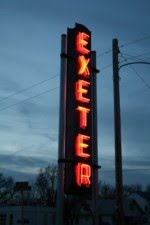Pages
- Home
- Exeter Village Ordinances - Chapter 1 Civil Admini...
- Exeter Village Ordinances: Municipal Planning
- Exeter Village Ordinances: Fire Regulations
- Exeter Village Ordinances: Public Utilities
- Exeter Village Ordninances: Public Ways and Proper...
- Exeter Village Ordinances: Business Regulations
- Exeter Village Ordinances: Vehicles and Traffic
- Exeter Village Ordinances: Misdemeanors
- Exeter Village Ordinances - Commissions and Boards...
- Stories from Exeter
- Photos from Exeter
- Exeter's Strategic Plan
- Exeter Community Guide
- Exeter Aquatic Center Rules
- Exeter Service Record Book World War I and II
VILLAGE OF EXETER
This blog is sponsored by the Village of Exeter and it is for all the past, present and future residents of Exeter. It is a place to comment on the happenings of Exeter and your place to inform the community
Saturday, April 12, 2014
Friday, April 11, 2014
Exeter-Milligan Update: Economics Class
Mr.
Jordan Marr’s economics class at Exeter-Milligan recently finished their
year-long business project. The students learned various aspects about
economics while being able to create their own business. The
students were able to raise over $1,000 for various charities, such as Skate
for Change and the I’ve Got A Name organization. Students making this project
possible, from left to right, are Front: Ingrid Remmen, Toni Bossaller - Back:
Deidre Stevens,Felix Richter, & Kaitlyn Hertzel.
Tuesday, April 8, 2014
Exeter-Milligan Update: Jump Rope for Heart a Success!
JUMP
ROPE FOR HEART EVENT AT EXETER-MILLIGAN A SUCCESS!
|
|
“I’m so pleased
with the success of this year’s event,” said Darcy White, Jump Rope For Heart
coordinator. “We all had a lot of fun, and the kids enjoyed learning about the
importance of physical activity and how they can play a role in saving lives.”
Jump Rope For Heart
is a program that promotes physical activity and heart health through jumping
rope. It is co-sponsored by the American Heart Association and the American
Alliance for Health, Physical Education, Recreation and Dance.
To make a donation or to find out
more about Jump Rope For Heart, call your nearest American Heart Association
office or call 1-800-AHA-USA1 (1-800-242-8721). You can also visit us online at
heart.org/jump.
Pictured is 2nd
grader Tyler Due, who raised the most donations of $315
Exeter-Milligan Update: English 7 - 12
Discovering the “AHA!” of Reading
Rhoda Wahl - English
7-12
The scene is a high school English class. Students are reading
chapter 14 of Ender’s Game, and journaling their reactions to the
chapter. After finishing the chapter, one student responded aloud, “I didn’t
see that coming.” This reaction was repeated during discussion and in journals,
as the readers reacted to the surprising end of the story. This collective “AHA!”
moment made dread of reading a 50-page chapter melt into the light of new
understanding. This is only one example of how students at Exeter-Milligan High
School are discovering strategies that help them discover the “AHA!” of
reading.
This path to discovery began with defining the reading process,
experimenting with a variety of reading strategies, and concluding that
learning is a lifetime process. Approximately 30% of the high school student
body was surveyed. This 5-question survey asked each respondent to define the
term “reading”, describe useful
reading strategies, rate his or her reading ability, and vote on which genre
(type of reading) each found easiest and most difficult to read. Their
definition of “reading” fell into two main categories.
·
25% - Recognizing familiar words, being able to
sound them out clearly, and the ability to read fluently (in a smooth manner)
and quickly.
·
75% - Finding meaning in written words (both
printed & digital), understanding the writer’s message, and learning something
new.
When asked to rate themselves as poor, average, good, or outstanding readers, the readers that limit
reading to word recognition and fluency rated themselves as average. In the survey, average means that the readers only
understand SOME of what is read. Most of the readers that define reading as a
meaning-making process rated themselves as good
or outstanding readers. Good refers to understanding MOST of
what is read, and outstanding readers
understand EVERYTHING they read.
Good and Outstanding readers are more effective because they regularly use simple
strategies that transform learning to read (word recognition) into reading to
learn (comprehension). Based on the survey, the strategies are listed from most
frequently used to those used less often.
1.
Self-Monitoring – All students who use
comprehension strategies recognize when they are stuck or don’t understand what
they are reading.
2.
Re-reading – Most of the time, students who
re-read a difficult section several times, or more slowly, will understand what
they are reading
3.
Questioning – Most effective readers ask
questions as they read. These questions could be about words or elements that
are confusing, or related elements they wonder about.
4.
Visualizing - About half of the effective readers
create pictures or movies in their head to visualize what is happening in the
text.
In his introduction to Ender’s Game, Orson Scott Card encourages
readers to create their own story, or find their own “AHA!” moment. He writes:
“The true story is one that the audience members create in their minds,
guided and shaped by my text, but then transformed, elucidated, expanded,
edited, and clarified by their own experience, their own desires, their own
hopes and fears.”
(Card, Orson S. Ender’s Game. Introduction, © 1991)
pictured reading are Katie Mounce, Kaitlyn Vavra, Janey
Erdkamp and Kelsey Bigelow.
Subscribe to:
Comments (Atom)





